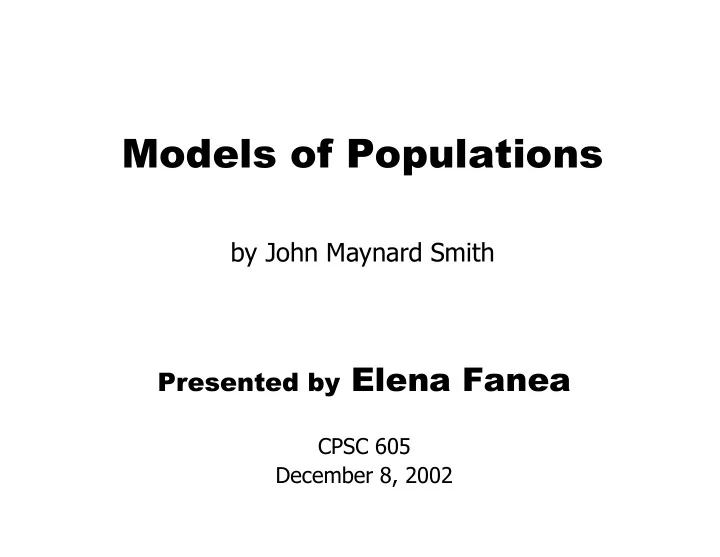

Models of Populations by John Maynard Smith Presented by Elena Fanea CPSC 605 December 8, 2002
The Message Simple models of population growth and evolutionary change can explain the answer to some important questions
Questions ? 1. 2. How accurate must the hereditary process be ? 3. How frequencies fluctuate in a finite population ?
Outline Models of population growth Selection in an asexual population The accuracy of replication Genetic drift in finite populations
Hypothesis Population growing asexually by binary fission Ex: bacteria contains x individuals at time t r· d t = Probability of division in d t r = const - intrinsic rate of increase
1. Models of Population Growth dx t 0 x rx t rx d Æ d = d æ æ Æ æ = dt Logarithmic rt x x e ln x ln x rt fi = fi = + growth 0 0
r = const ? Synchrony - Lotka’s theorem Inherited differences between cells
Natural Selection Malthus fi Darwin & Wallace – natural selection dx x Ê - ˆ rx 1 K=carrying capacity = ⋅ Á ˜ dt K Ë ¯ Logistic Equation
2. Selection in an Asexual Population dx x Ê - ˆ { r x 1 Á ˜ x K 1 = ⋅ Á ˜ 1 dt K Ë ¯ 1 dy y Ê - ˆ r y 1 y K 2 Á ˜ = ⋅ 2 Á ˜ dt K Ë ¯ 2 Populations limited by different resources They will coexist indefinitely => no selection
Selection in an Asexual Population (Cont.) dx x y Ê ˆ { + r x 1 Á ˜ = ⋅ - 1 Á ˜ dt K Ë ¯ 1 dy x y Ê ˆ + r y 1 Á ˜ = ⋅ - Á ˜ 2 dt K Ë ¯ 2 Populations have the same resources } => K 1 >K 2 => x until x+ y = K 1 x selectively y 0 eliminates y
Selection in an Asexual Population Conclusion Natural selection replacement IIF The two types are limited by the same factors (are competing for resources)
3. The Accuracy of Replication Replication Exact No process evolution Too inaccurate Critical accuracy Q depends on: • Success of non-optimal copies • Average number of copies produced by optimal particles In practice, evolution is unlikely if Q<1/2
The Accuracy of Replication – Cont. Practical implication -> genome's size limited A genome of n nucleotides, u =error of replication/nucleotide Q=(1- u ) n @ e –nu => nu <1 Error rates u non-enzymic replication 10 -1 -10 -2 RNA replication (without “proof-reading” ) 10 -3 -10 -4 DNA replication (with “proof-reading”) 10 -9 -10 -10
The Accuracy of Replication – Cont. Population of replicating RNA molecules S- optimal sequence, unique, produces copies at rate R >r Q-the probability to produce an exact copy of itself dx 0 RQx = 0 dt + dx 1 ( ) rx R 1 Q x = + - ⋅ 1 0 dt ( ) d x x + 0 1 ( ) Rx rx D x x = + - + 0 1 0 1 dt
The Accuracy of Replication – Cont. If deaths = births, can optimal molecules survive? Rx rx + p=proportion of optimal molecules 0 1 ( ) D Rp r 1 p = = + - x x + 0 1 dx 0 [ ( ) ] RQ Rp r 1 p x = - + - ⋅ 0 dt r ( ) Q p 1 p at equilibrium fi = + - R r Q @ R
4. Genetic Drift in Finite Populations =fluctuations of proportions of different kinds of populations fl type a - no selection - type A ‡ p - frequencies - q Np - # of individuals - Nq
Genetic Drift in Finite Populations (Cont.) Next generation p’, q’ – frequencies E(p’)=p – expected value - unchanged E(q’)=q V=E(p’-p’) 2 => V=E(p’-p) 2 – variance s (p’)=V 1/2 –standard deviation
Genetic Drift in Finite Populations (Cont.) Family size has a Poisson distribution Each offspring was assigned randomly to one parent, independently Has a probability p of being a The probabilities of 0, 1, 2…N offspring of type a : p N , Np N-1 q, N(N-1)/2p N-2 q 2 , …, q N
Genetic Drift in Finite Populations (Cont.) The binomial theorem: Number of a Frequencies of individuals a individuals Mean p Np pq Variance Npq N Standard pq Npq deviation N
Genetic Drift in Finite Populations (Cont.) Each new individual is equally likely to be produced by any one of the N parents After 2N generations, all will descend from the same individual Standard error >= N
Genetic Drift in Finite Populations Conclusion No natural selection=>fluctuant frequencies Population => fluctuations One type will ultimately become fixed, by chance Simulation
Summary Mathematical models can describe Population growth Selection in an asexual population The accuracy of replication Genetic drift in finite populations And many other aspects of evolution
References John Maynard Smith – Evolutionary Genetics, second edition, Oxford University Press, 2000 chapter 2
Recommend
More recommend